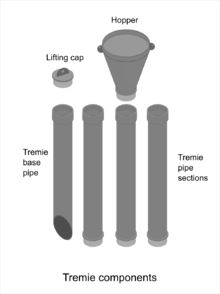

A tremie is a watertight pipe, usually of about 250 mm inside diameter (150 to 300 mm),[1] with a conical hopper at its upper end above the water level. It may have a loose plug or a valve at the bottom end. A tremie is usually used to pour concrete underwater in a way that avoids washout of cement from the mix due to turbulent water contact with the concrete while it is flowing. This produces a more reliable strength of the product.[2] Common applications include:
- Caissons, which are the foundations of bridges, among other things, that span bodies of water.
- Pilings.[1]
- Monitoring wells. Builders use tremie methods for materials other than concrete, and for industries other than construction. For example, bentonite slurries for monitoring wells are often emplaced via tremie pipe.[3]
- ^ a b "Concrete Pumping Products - Tremie Pipes". we-couplings.com. Anderton, Lancashire: W.E. Couplings Ltd. Retrieved 1 June 2017.
- ^ Cite error: The named reference
how towas invoked but never defined (see the help page). - ^ Nielsen, David, ed. (1991). Practical handbook of ground-water [sic] monitoring. CRC Press LLC. p. 321. ISBN 0-87371-124-6.
In wells more than about 50 feet deep, granular bentonite may be mixed with water and conveyed through a tremie pipe from the surface directly to its intended depth in the annulus. Pelletized bentonite is not effectively installed through tremie pipes.